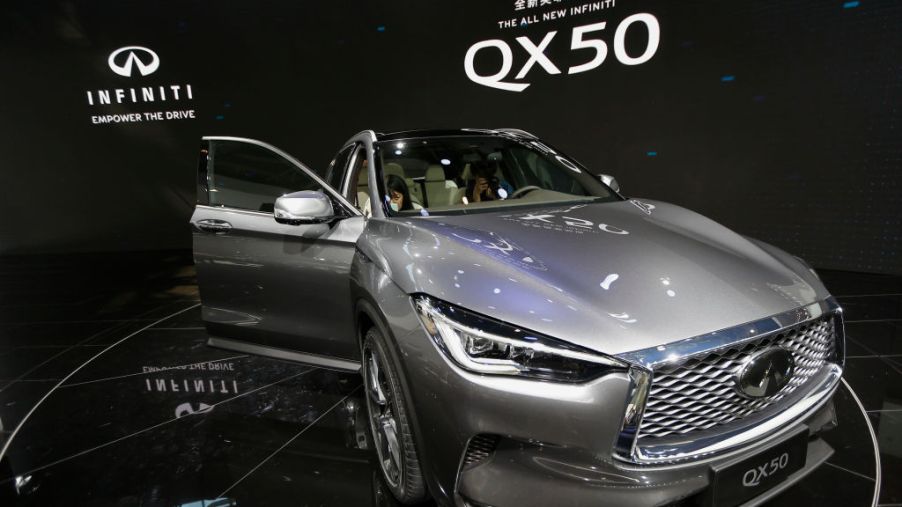
The 2020 Infiniti QX50 Shows Why Trusting EPA Estimates Can Be Risky
When it comes to luxury compact SUVs, the Infiniti QX50 has quite a reputation with its inspirational design and innovative engine. That doesn’t, however, put it at the top of its class. The Infiniti QX50’s 2.0-liter VC-Turbo engine, the first engine to use variable-compression technology, was first installed in the 2019 Infiniti QX50. When tested, its EPA fuel economy ratings matched the test results.
With the release of the 2020 models of the QX50, its EPA figures noticeably dropped. What happened?
What changed between 2019 and 2020?
According to the team at MotorTrend, Infiniti’s 2.0-liter VC-Turbo four-cylinder engine debuted at the official fall 2016 Paris Motor Show. The new engine could produce V6 power using no more gas than a regular four-cylinder engine. It utilized new Rube Goldberg multi-link piston connecting rods.
In the 2019 Infiniti QX50, the engine was rated at 268 hp at 5,600 rpm. It got 280 lb-ft of torque at 4,400 rpm. It was impressive because when compared to the engine of the previous generation, a 3.7-liter V6, the figures weren’t substantially different. The V6 was rated at 325 hp at 7,000 rpm, and at 5,200 rpm, it got 267 lb-ft of torque.
Thanks to the connecting rods, the new VC-Turbo engine could change its compression ratio on the go. It could raise the ratio to cruise on easy roads and save gas. It could drop the ratio for more power when needed.
When the 2019 Infiniti QX50 debuted, its EPA estimates matched the expectation of big power and great fuel efficiency. It offered 24 mpg city, 31 mpg highway, and 27 mpg combined, which are numbers on par with regular four-cylinder engines. The numbers, with either all-wheel or rear-wheel drive, were impressive when matched against the V6 from earlier models.
According to MotorTrend, the new engine increased fuel economy by 30 percent combined while performance only lowered by 5 percent. Not bad. When MotorTrend conducted their own test, they found their numbers to be pretty close.
When the 2020 models came out, the EPA estimates were lower. Now for the front-wheel-drive models, they were rated at 23/29/26 city/highway/combined mpg, and for the all-wheel-drive models, EPA estimates were 22/28/25 city/highway/combined mpg. There were hardly any changes between the 2019 and 2020 models of the Infiniti QX50, so why did the numbers fall?
Fuel efficiency that fell short
MotorTrend reports that Infiniti’s explanation was that since enhanced standard equipment was added to some trim levels for the 2020 model year, the inertia weight class increased and “the adoption of heightened particulate matter emissions controls.”
What does that mean exactly? A fully-equipped AWD 2020 QX50 has enough optional equipment to push the Infiniti up a few inertia weight classes. The classes are approximated classifications established by the EPA for emissions testing. It’s not an indicator that the EPA numbers weren’t correct before. It does tell us something about how they come up with the fuel economy numbers.
When a new car debuts, there’s no way of knowing how many will go for the basic stripped-down model and how many will go top shelf. The manufacturer makes an educated guess. They decide which model they anticipate will sell the best and use its inertia weight class for the estimated fuel economy of a given powertrain. If the guess is on the lighter side, the EPA numbers may be better than on other trims. If they guessed heavier, the EPA numbers will be lower.
After the first year, the inertia ratings are updated to reflect the data the automaker now has based on sales. No more guessing. The 2020 Infiniti QX50 most are selecting is just a lot heavier than the original estimates, and that’s why there was a change in the EPA numbers between 2019 and 2020 models.
The 2020 Infiniti QX50’s pros and cons
The new Infiniti QX50 has an impressive list of standard safety features and offers a composed ride with nice handling. The QX50 still has that unique engine, but its performance is underwhelming. It’s mated to a continuously variable automatic transmission that fails to properly use applicable power. Under heavy throttle, the engine is pretty loud.
The cabin is upscale, spacious, and there’s plenty of cargo space. A lot of luxury features are only available with the higher trim levels like navigation and leather upholstery. The QX50 now has Android Auto and Apple CarPlay and got a new infotainment system too. It features dual HD displays that many find a bit complex.
There are two new trim levels – Sensory and Autograph.
The new 2020 Infiniti QX50 is a quality luxury compact SUV, and it’s worth taking a look at. If a luxury vehicle with a smooth ride is enough for you, you might choose the QX50. Is it at the top of its class? Not with the 2020 models.


